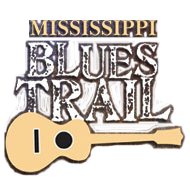Furry Lewis
Furry Lewis - Greenwood
Greenwood native Walter “Furry” Lewis (c. 1899-1981) was a favorite figure on the Memphis blues revival scene of the 1960s and ’70s, decades after he made his historic first recordings in the 1920s. Lewis, who had worked as a street sweeper for the city of Memphis in the interim, made numerous new recordings and also appeared on television shows and in motion pictures. His family lived on Lamar Street before moving to Memphis when Lewis was a youngster.
Furry Lewis was one of the first blues guitarists from Mississippi or Memphis to enter a recording studio when he traveled to Chicago to record six songs for the Vocalion label on April 20, 1927. Lewis lived in Memphis almost all of his life, but he was born in Greenwood (the 1900 census lists him as a one-year-old born in March of 1899, residing with his mother and other relatives in the house of his grandparents on Lamar Street, though other documents cite birth dates of March 6, 1893, and 1895.) By 1901 he was living in Memphis with his mother and siblings. Lewis, nicknamed Furry by childhood friends, became an active musician in his teens, playing mostly by himself but sometimes teaming with other musicians. He often told stories of playing with W. C. Handy and of the “first good guitar” he owned, a gift from Handy. Lewis, who lost a leg while trying to hop a freight train in Illinois, traveled with a medicine show, played on the streets and at parties, picnics, and saloons, and offered late-night serenades in front of homes. His 1927-29 Vocalion and Victor recordings, now regarded as some of the finest examples of early blues, included ragtime-influenced pieces, Delta-style blues (some played with a bottleneck), and folk hero ballads. However, music did not provide a livelihood for Lewis, whose jobs for the city of Memphis ranged from garbage man to night watchman to street sweeper.
He was able to build a new musical career in the 1960s after author Sam Charters produced his first LP in 1959. Other records followed, along with performances around the country for the new folk-blues audience, and Lewis, always a showman and humorist, became one of the most celebrated characters in Memphis. He endeared himself to a young circle of fans, writers, and musicians who visited him, chauffeured him to gigs, and took turns going to the local pawn shop to recover his guitar or wooden leg. His profile grew in the 1970s with appearances on television shows (including The Tonight Show with Johnny Carson) and in films (most notably W. W. and the Dixie Dance Kings). He opened a concert for the Rolling Stones and had a song (“Furry Sings the Blues”) written in his honor by folk singer Joni Mitchell. His album Live at the Gaslight, recorded in New York City in 1971, was produced by a writer (Jim Nash) who said he first learned about Lewis from Jimi Hendrix. Lewis died on September 14, 1981. He was elected to the Blues Hall of Fame in 2012.
Lewis was one of many noted blues guitarists from Leflore County. Others, either natives or onetime residents, who also made records include Rubin Lacy, Tommy McClennan, Robert Petway, Honeyboy Edwards, Robert Johnson, Richard “Hacksaw” Harney, Elmore James, James Scott, Jr., L. C. Green, Eddie “Guitar Slim” Jones, Hubert Sumlin, Hound Dog Taylor, Brewer Phillips, Luther “Guitar Jr.” Johnson, David Dee, Dion Payton, and Fenton Robinson.
content © Mississippi Blues Commission
[ BACK TO TOP ]

